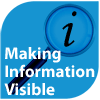 Easing the Information Flow with Data and Network Maps
Easing the Information Flow with Data and Network Maps
Jinfo Blog
2nd April 2015
Abstract
Sophie Alexander looks at how data and network maps can help us to make data-driven decisions and to identify and breakdown information silos.
Item
 My previous blog highlighted suggestions for facilitating information discovery in the enterprise using tools that go beyond technology.
My previous blog highlighted suggestions for facilitating information discovery in the enterprise using tools that go beyond technology.
This blog focuses on Constance Ard's article "Taking the Mystery Out of Big Data - Moving from Data Collection to Competitive Actions", and looks at how data and network maps can be used to identify how information flows within an organisation and to support the goal of making actionable information highly visible.
As Constance reminds us, making data-driven decisions depends on discovering the right information in the right format at the right time. Businesses rely on both internal and external data to function and information silos are a familiar challenge. She suggests that perhaps the best way to identify any silos and break down barriers is for a process to falter.
Data and Network Maps
Data and network maps are an effective way to identify information flows within an organisation and can help make information more visible.
A data map is "a comprehensive and defensible inventory of an organisation's IT systems that store information - electronically stored information or ESI - which may be relevant to litigation, regulatory proceedings, government investigations, or audits" (as defined by John P. Collins of The Ingersoll Firm - PDF). This shows how information moves in and out of the organisation but network maps can be useful to show how information moves within a company.
Constance points out that the difference between a data map and a network map is that the network map concentrates on an organisation's hardware and the connections to networks and domains, network maps are highly technical and may need to be translated into business speak.
Whilst designing workflows that ease information discovery is important, Constance reiterates that technology is only one aspect of this.
Analytics and Other Options
For visibility in the context of content seeking, federated search and discovery products such as InfoNgen have their place but that still only represents a small fraction of what knowledge workers do with information in today's workplace.
Project collaboration and sharing is another important area. Products such as Microsoft's Delve can highlight information based on what you're working on and what's trending around you. This is done via their Office Graph which shows you what may be "relevant" or "interesting" to you. Other tools such as Tallyfy focus more on workflow, enabling managers to easily share processes to make information more visible within organisations.
Analytics and big data are still significant and whilst visualisation tools can be beneficial in this area, decision-makers need to be clear on their objectives overall and processes need to be regularly reviewed to adapt with the needs of the business.
This Blog Item is part of the FreePint Topic Series "Making Information Visible".
- Blog post title: Easing the Information Flow with Data and Network Maps
- Link to this page
- View printable version
- Q&A with Tallyfy - Innovations in Information Delivery
Monday, 30th March 2015 - Facilitating Discovery and Delivering Awareness for Users
Monday, 30th March 2015 - Putting Users at the Centre of Discovery
Wednesday, 25th March 2015 - Taking the Mystery Out of Big Data - Moving from Data Collection to Competitive Actions
Monday, 2nd February 2015 - Introducing Delve - Improving Interaction with Information in Office 365
Monday, 22nd September 2014 - Product Review of InfoNgen: Introduction, Value and FreePint's View
Thursday, 5th December 2013
- Adopting a More Holistic Approach to Discovery Within the Enterprise
Wednesday, 25th March 2015 - Why Good Information Management is Central to Competitive Advantage
Thursday, 5th February 2015
Register for our next Community session:

Team demand and AI
22nd January 2026
Latest on our YouTube channel:
Read on the Blog:
December 2025 update
3rd December 2025
- Team roles and AI (Community) 26th February 2026
- Team demand and AI (Community) 22nd January 2026
- Transforming knowledge management at BASF – GenAI and the evolution of QKnows (Community) 10th December 2025